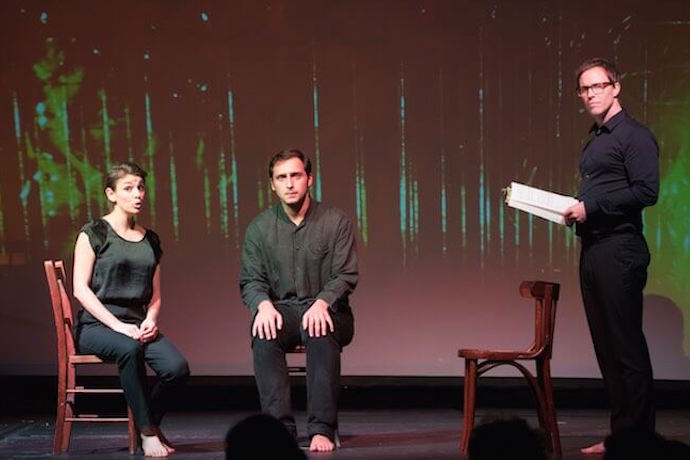
Raphaela Papadakis, Joseph Padfield and Nathan Vale in Michael Nyman’s The Man Who Mistook His Wife for a Hat
Institute of Contemporary Art, London
By Christopher Webb
Produced by City Music Foundation and performed at the Institute of Contemporary Art, I, Object unites two chamber operas with a common theme: both The Man Who Mistook his Wife for a Hat (1986) and Unknown Position (2011) contain characters whose radically-different experience of objects has altered their relationships with the people closest to them.
Kate Whitley’s 20-minute piece Unknown Position opened the double bill with its account of objectophilia, a condition that sees those affected becoming sexually attracted to inanimate objects—and, in rare instances, even pursuing committed relationships with them. In the case of the protagonist (created by soprano Raphaela Papadakis), we see the relationship with her partner (tenor Nathan Vale) crumble as she edges closer—both figuratively and literally—to a chair, placed front of stage. While the orchestra provides stirring, elegiac moments, it’s difficult at times to work out the opera’s mood as it suddenly shifts from depicting serious mental anguish to scenes of lighter comedy. As the protagonist lovingly strokes the chair in front of her—her partner sits despondently on another chair upstage—the percussion suggests a happiness and intimacy lacking in her human relationship. It’s this tableau which allows us to understand that she reveals herself to the object of her desire in a way she never possibly could to her lover upstage. As she kneels down beside the chair to fumble its contours—‘Before I met you I felt insecure,’ she sings in aria—we are unsure whether to laugh or not. It’s this strange ambiguity, however, that lends the piece its odd power.
Dr. P (bass-baritone Joseph Padfield), in Michael Nyman’s The Man Who Mistook his Wife for a Hat, inhabits an entirely different world, one defined by a rare condition called visual agnosia. He sees objects and people yet is unable to recognise or interpret them, which makes Dr. P the converse to the protagonist of Unknown Position. While she imbues her chair with heightened sensibilities, he has lost all ability to ‘see’ things, which prevents him from enjoying any meaningful relationship with his surroundings. Padfield does an excellent job of playing the role of the unwitting patient whose life becomes a chaotic swirl of abstract shapes. This is perhaps exemplified best when he sits motionless in the chair as his doctor (Vale) and wife (Papadakis) rush around him, attempting to piece together what it is he sees before him. Nyman’s neurological opera is both sensitive and rousing. It combines well with the libretto (Christopher Rawlence) to allow the drama to evolve through sounds and lyrics rather than explicit narrative description. It is a touching piece and a fitting treatment of Oliver Sack’s most perplexing case study. As Sacks himself noted: ‘one would not have thought, on principle, that such matters of neurology or epistemology could be explored in an opera’ but, in fact, it turns out to be the ‘perfect medium.’ ![]()